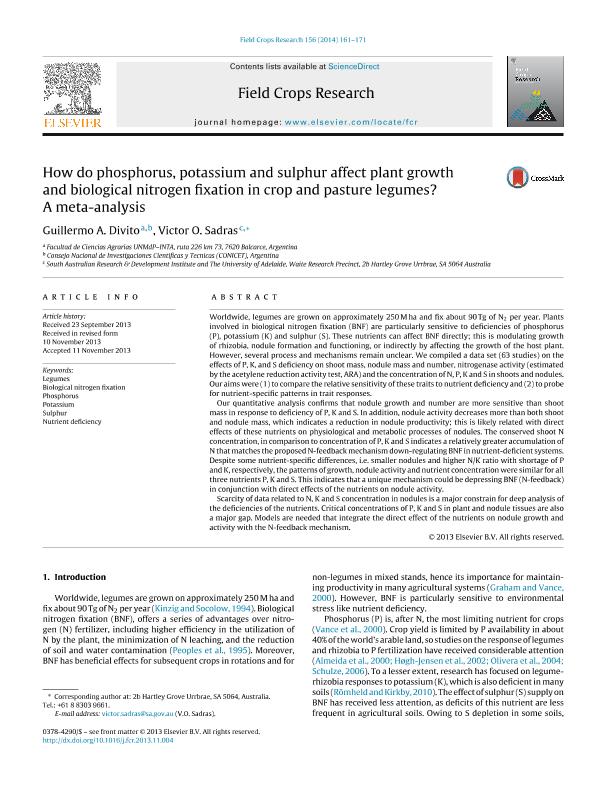Mostrar el registro sencillo del ítem
dc.contributor.author
Divito, Guillermo Adrián

dc.contributor.author
Sadras, Victor Oscar

dc.date.available
2017-10-02T18:40:46Z
dc.date.issued
2014-02-01
dc.identifier.citation
Divito, Guillermo Adrián; Sadras, Victor Oscar; How do phosphorus, potassium and sulphur affect plant growth and biological nitrogen fixation in crop and pasture legumes? A meta-analysis; Elsevier Science; Field Crops Research; 156; 1-2-2014; 161-171
dc.identifier.issn
0378-4290
dc.identifier.uri
http://hdl.handle.net/11336/25635
dc.description.abstract
Worldwide, legumes are grown on approximately 250 M ha and fix about 90 Tg of N2 per year. Plants involved in biological nitrogen fixation (BNF) are particularly sensitive to deficiencies of phosphorus (P), potassium (K) and sulphur (S). These nutrients can affect BNF directly; this is modulating growth of rhizobia, nodule formation and functioning, or indirectly by affecting the growth of the host plant. However, several process and mechanisms remain unclear. We compiled a data set (63 studies) on the effects of P, K, and S deficiency on shoot mass, nodule mass and number, nitrogenase activity (estimated by the acetylene reduction activity test, ARA) and the concentration of N, P, K and S in shoots and nodules. Our aims were (1) to compare the relative sensitivity of these traits to nutrient deficiency and (2) to probe for nutrient-specific patterns in trait responses. Our quantitative analysis confirms that nodule growth and number are more sensitive than shoot mass in response to deficiency of P, K and S. In addition, nodule activity decreases more than both shoot and nodule mass, which indicates a reduction in nodule productivity; this is likely related with direct effects of these nutrients on physiological and metabolic processes of nodules. The conserved shoot N concentration, in comparison to concentration of P, K and S indicates a relatively greater accumulation of N that matches the proposed N-feedback mechanism down-regulating BNF in nutrient-deficient systems. Despite some nutrient-specific differences, i.e. smaller nodules and higher N/K ratio with shortage of P and K, respectively, the patterns of growth, nodule activity and nutrient concentration were similar for all three nutrients P, K and S. This indicates that a unique mechanism could be depressing BNF (N-feedback) in conjunction with direct effects of the nutrients on nodule activity. Scarcity of data related to N, K and S concentration in nodules is a major constrain for deep analysis of the deficiencies of the nutrients. Critical concentrations of P, K and S in plant and nodule tissues are also a major gap. Models are needed that integrate the direct effect of the nutrients on nodule growth and activity with the N-feedback mechanism.
dc.format
application/pdf
dc.language.iso
eng
dc.publisher
Elsevier Science

dc.rights
info:eu-repo/semantics/openAccess
dc.rights.uri
https://creativecommons.org/licenses/by-nc-sa/2.5/ar/
dc.subject
Legumes
dc.subject
Biological Nitrogen Fixation
dc.subject
Phosphorus
dc.subject
Potassium
dc.subject
Sulphur
dc.subject
Nutrient Deficiency
dc.subject.classification
Otras Agricultura, Silvicultura y Pesca

dc.subject.classification
Agricultura, Silvicultura y Pesca

dc.subject.classification
CIENCIAS AGRÍCOLAS

dc.title
How do phosphorus, potassium and sulphur affect plant growth and biological nitrogen fixation in crop and pasture legumes? A meta-analysis
dc.type
info:eu-repo/semantics/article
dc.type
info:ar-repo/semantics/artículo
dc.type
info:eu-repo/semantics/publishedVersion
dc.date.updated
2017-09-29T14:44:59Z
dc.journal.volume
156
dc.journal.pagination
161-171
dc.journal.pais
Países Bajos

dc.journal.ciudad
Amsterdam
dc.description.fil
Fil: Divito, Guillermo Adrián. Universidad Nacional de Mar del Plata. Facultad de Ciencias Agrarias; Argentina. Consejo Nacional de Investigaciones Científicas y Técnicas; Argentina
dc.description.fil
Fil: Sadras, Victor Oscar. University of Adelaide; Australia
dc.journal.title
Field Crops Research

dc.relation.alternativeid
info:eu-repo/semantics/altIdentifier/url/http://www.sciencedirect.com/science/article/pii/S0378429013003833
dc.relation.alternativeid
info:eu-repo/semantics/altIdentifier/doi/http://dx.doi.org/10.1016/j.fcr.2013.11.004
Archivos asociados
